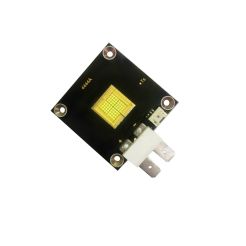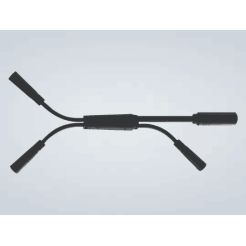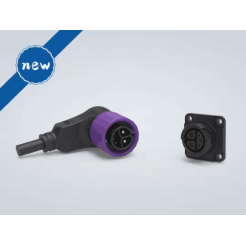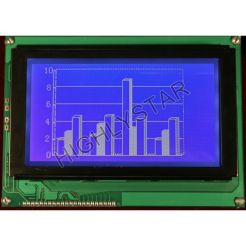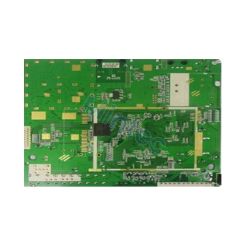CWDM Mux
Product Description
https://www.raycomsecurity.com/productstags/cwdm-mux.html
CWDM Mux
CWDM Mux (Coarse Wavelength Division Multiplexing Multiplexer) is a device used in optical fiber communication networks to combine multiple optical signals with different wavelengths onto a single optical fiber. It is a passive device that operates based on the principle of Wavelength Division Multiplexing (WDM), which allows multiple signals to be transmitted simultaneously over the same fiber by using different wavelengths of light.
Here's how CWDM Mux works
Wavelength Separation: CWDM Mux can handle a range of wavelengths (typically 1270 nm to 1610 nm) in the optical spectrum. Each input signal corresponds to a different wavelength. These wavelengths are separated by a specific interval, usually 20 nm.
Combining Signals: CWDM Mux combines multiple input signals, each operating at a different wavelength, into a single output fiber. The combined signals travel together over the same fiber, but they don't interfere with each other due to their distinct wavelengths.
Passive Operation: CWDM Mux is a passive device, meaning it doesn't require power or electronic components to operate. It simply uses the characteristics of the optical signals to separate and combine them.
Multiplexing and Demultiplexing: At the receiving end, another CWDM Mux or a CWDM Demux is used to separate the combined signals back into their individual wavelengths. This allows the original data streams to be retrieved and sent to their respective destinations.
Benefits of CWDM Mux
Increased Fiber Capacity: CWDM Mux enables multiple signals to share a single optical fiber, effectively increasing the capacity of the fiber network without the need for laying additional physical fibers.
Cost-Efficiency: Since CWDM Mux is a passive device, it is cost-effective to deploy and maintain compared to active devices that require power and active components.
Simplicity: The passive nature of CWDM Mux makes it easy to install and operate. It doesn't require complex configuration or ongoing management.
Scalability: CWDM Mux systems can be easily expanded by adding additional wavelengths to accommodate growing network demands.
Compatibility: CWDM Mux is compatible with various optical signals, including data, voice, and video, making it versatile for different types of applications.
Interoperability: CWDM Mux systems are typically vendor-agnostic, allowing different equipment from various manufacturers to work together seamlessly.
Distance Extension: CWDM Mux can extend the reach of optical signals by compensating for losses in the fiber, enabling data transmission over longer distances.
CWDM Mux is commonly used in metropolitan and access networks, where the demand for efficient utilization of optical fibers and cost-effective solutions is high. It provides an elegant way to maximize the capacity of existing fiber infrastructure and accommodate the ever-growing data communication needs.
Application
Metropolitan Area Networks (MANs): CWDM Mux is often used in MANs to consolidate multiple data streams from different locations onto a single fiber, optimizing network capacity and reducing the need for laying additional fibers.
Access Networks: In access networks, CWDM Mux is employed to aggregate traffic from multiple subscribers, such as homes or businesses, onto a central fiber network. This allows service providers to efficiently manage and deliver various services to customers.
Enterprise Networks: Large organizations with multiple office locations can use CWDM Mux to connect their facilities with high-speed, cost-effective optical links. This helps in maintaining seamless communication and data transfer between offices.
Data Centers: Data centers utilize CWDM Mux to consolidate and transmit high volumes of data between servers, storage systems, and networking equipment. It's used to efficiently manage the growing demands of data traffic within the data center.
Telecommunication Backbones: CWDM Mux can be used in long-haul telecommunications networks to combine and transmit multiple high-speed data streams over a single optical fiber, optimizing bandwidth utilization.
Wireless Backhaul: For wireless communication networks, CWDM Mux can be used to transport data between base stations and central network hubs, providing high-capacity connectivity.
Internet Service Providers (ISPs): ISPs use CWDM Mux to aggregate traffic from different customers and deliver it to their core network infrastructure. This helps in optimizing network resources and ensuring efficient data delivery.
Video Broadcasting: In video broadcasting applications, CWDM Mux can be employed to transmit multiple channels of video content over a single fiber, making it suitable for broadcasting and cable TV distribution.
Security Surveillance: For surveillance systems that rely on optical fibers to transmit video feeds from multiple cameras, CWDM Mux can consolidate these feeds onto a single fiber for transmission to a monitoring station.
Healthcare: Healthcare facilities can use CWDM Mux to transmit large medical image files, patient records, and other critical data between different departments or remote locations.
Research and Education Networks: Universities, research institutions, and laboratories can benefit from CWDM Mux to interconnect various research facilities and departments for data sharing and collaboration.
Oil and Gas Industry: In remote oil and gas exploration sites, CWDM Mux can help connect monitoring and control systems with central offices, ensuring efficient data communication.
Financial Institutions: Financial companies that require high-speed and secure data transmission between branches, trading floors, and data centers can use CWDM Mux for reliable connectivity.
Emergency Response Networks: Public safety and emergency response agencies can utilize CWDM Mux to enhance communication among different agencies during critical situations.

